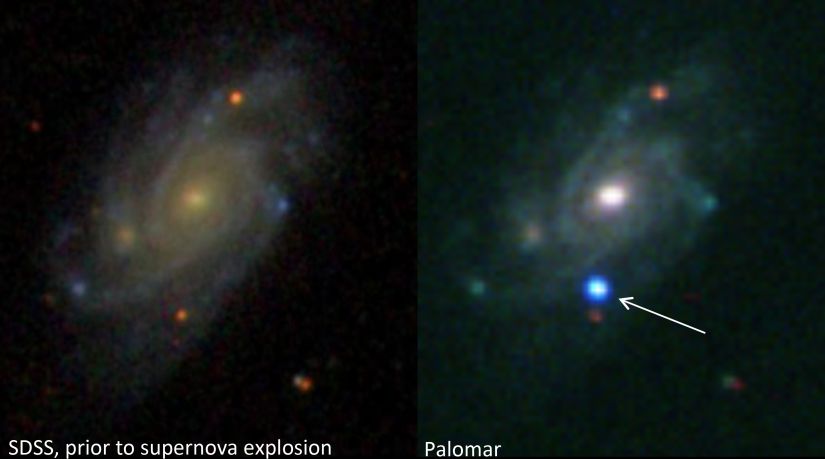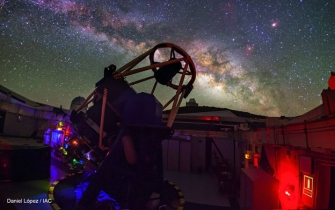
The explosive death of another massive star caught by the iPTF survey. The image on the right is from the SDSS prior to the supernova explosion. Image credit: Gal-Yam et al 2014, Nature; May 22, 2014
2017
14 FebGROWTH scientists are part of a study that captures the earliest stages of a supernova
Using an array of telescope facilities around the world, an international team of astronomers, among them many GROWTH scientists, recorded the fading light from a supernova – a violent explosion before a star dies - just hours after it occurred in a not so distant spiral galaxy in Pegasus constellation. Seen for the first time in multiple wavelengths from infrared to optical and X-ray, these earliest moments after detonation reveal important secrets about an elusive period in star evolution.
Back in October 2013, the intermediate Palomar Transient Factory – an optical survey designed to capture exotic fast changing cosmic events known as transients – was in full swing. A camera mounted on the 48" telescope at the Palomar Observatory, managed by Caltech, was scanning the skies repeatedly. Fast algorithms would sieve through the data looking for differences in the images produced by consecutive scans. Such differences could indicate an interesting transient taking place and a selection of promising candidates would be recorded in a database. A large team of astronomers would then look at the database and schedule coordinated follow-up observations with multiple facilities across the world to study the transients in detail.
This was the routine, which preceded the study of iptf13dqy (SN2013fs) – a massive star roughly 10 times the size of our sun – whose sudden change in brightness was caught by the telescope in Palomar. Initial data suggested that this is a regular type II supernova. This class of supernovae have masses much larger than our sun and eventually implode under their own weight as the thermonuclear reaction in their core slowly dies out. Astronomers in the iPTF collaboration swiftly pointed one of the most powerful telescopes in the world, the W.M Keck in Hawaii in the direction of SN2013fs.
Other telescopes in Spain and Australia followed up in the coming days and months yielding a unique set of data across multiple wavelengths. First, astronomers confirmed that they had caught the dying star just 3 hours after it had exploded. Spectroscopic data collection started 3 hours later and revealed floating ionized oxygen and helium atoms whose signature suddenly disappeared several hours later. This led the team to conclude that the star must have ejected a fair amount of gas material prior to its explosion and the supernova light ionized this gas as it traveled through it. The same set of data was then used to estimate the thickness of the gas layer and how long before the star exploded it was ejected from its surface.
Such massive starts are known to randomly shed material to their surroundings but this is the first detailed study of this specific period in the evolution of stars, which is still poorly understood. The results were published this week in Nature Physics.
Using W. M. Keck Observatory we were able to obtain what we call flash spectra. The flash spectra gave us a direct view of the astro-chemistry of the star within the first few hours after explosion and before the supernova blast wave swept everything away, providing a unique probe to understanding stellar evolution.
said Mansi Kalsiwal, an assistant professor of Astronomy at Caltech and a co-author on the paper.
“Do all massive stars form such gas layer known as circumstellar medium (CSM)?”, “What is its composition?”, “How dense and massive it is?” are all questions that so far have had no answers because the CSM is swiftly blown away by the supernova shock wave. To catch the moments before that happens astronomers need to be able to detect and conduct follow up studies of supernovae in the first ~20 hours after they die.
This and other similar studies prompted some iPTF team members to conceive the GROWTH project. Awarded generous funding by the National Science Foundation in Oct 2015, the Global Relay of Observatories Watching Transients Happen (GROWTH) uses transient detection facilities like iPTF, its successor the Zwicky Transient Facility (ZTF), and LIGO to trigger a global network of observatories for rapid follow-up observations within the first 24 hours after detection. GROWTH observatories are positioned longitudinally around the world to ensure access to the night sky that is uninterrupted by daylight. Within its lifetime, the project will catch and study the early stages of numerous supernovae, get the first glimpses of merging neutron stars and chart out the orbits of fast-moving near-earth asteroids to vastly expand our understanding of the transient universe.
More Information
Confined dense circumstellar material surrounding a regular type II supernova, Nature Physics, Feb 13, 2017
News coverage: Washington Post,
Science Magazine, Popular Science,
The Guardian
Ars Technica
Contact
Iva Kostadinova
GROWTH Communications and Media Contact
ivonata@caltech.edu
+1 626 395 2952




